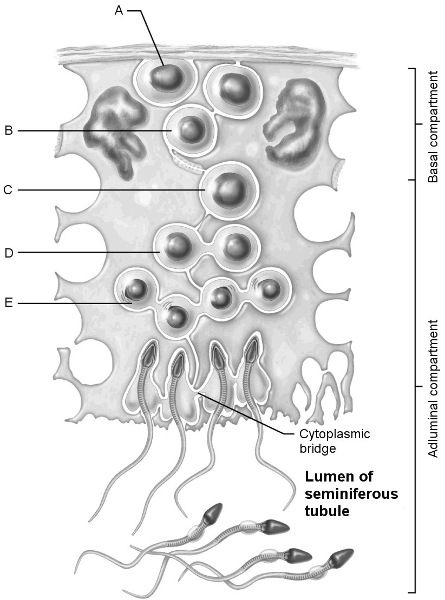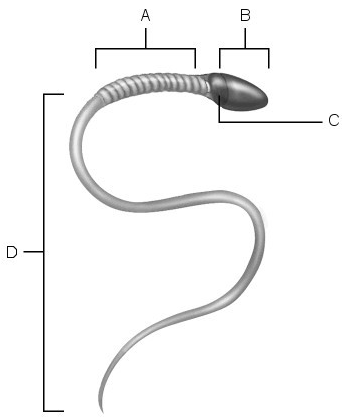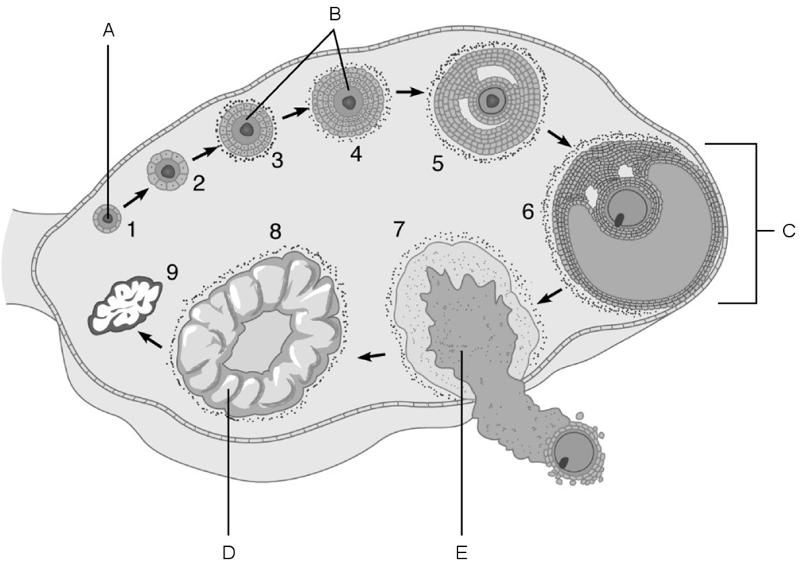
1) Stem cell.
2) First cells with n number of
chromosomes.
3) Type B spermatogonia.
4) Early
spermatids.
5) Primary spermatocyte.
1. A
2. D
3. B
4. E
5. C

6) Acrosome.
7) Location of mitochondria.
8)
Midpiece.
9) Location of nucleus.
10) Area of compacted
DNA.
11) Flagellum.
1. B
2. A
3. A
4. C
5. C
6. D

12) The stage called ovulation.
13) Vesicular (Graafian)
follicle.
14) Primary follicles.
15) Primordial
follicle.
16) Corpus luteum.
17) Mature follicle.
12. E
13. C
14. B
15. A
16. D
17. C
1) The dartos and cremaster muscles are important to the integrity of
the male reproductive
system. Which of the following is true
about the role they play?
A) They contract to push sperm along
the ductus deferens.
B) They regulate the temperature of the
testes.
C) They are responsible for penile erection.
D) They
contract to allow ejaculation.
B) They regulate the temperature of the testes.
2) The ability of sperm cells to move along the ductus deferens is
due to ________.
A) gravity
B) peristaltic
contractions
C) enzymatic activity
D) hormonal action
B) peristaltic contractions
3) The ability of a male to ejaculate is due to the action of ________.
D) the bulbospongiosus muscles
4) The most important risk for testicular cancer in young males is ________.
C) nondescent of the testes
5) Which of the following glands are responsible for 60% of the synthesis of semen?
C) the prostate
6) Which of the following hormones controls the release of anterior pituitary
gonadotropins?
C) GnRH
7) Development of male reproductive structures depends on which of the following events?
C) secretion of male hormones prenatally and lasting into the first few months after birth
8) The primary function of the uterus is to ________.
D) receive, retain, and nourish a fertilized ovum
9) Why is the bloodtestis
barrier important?
A) because spermatozoa and developing cells produce surface antigens
that are recognized
as foreign by the immune system
10) The structures that receive the ovulated oocyte, providing a site
for fertilization, are
called the ________.
B) fallopian tubes
11) If gametes were diploid like somatic cells, how many chromosomes
would the zygote
contain?
A) twice the diploid number, and with every succeeding generation,
the chromosome
number would continue to double and normal
development could not occur
12) Human egg and sperm are similar in that ________.
C) they have the same number of chromosomes
13) The constancy of the chromosome number from one cell generation
to the next is
maintained through ________.
B) meiosis
14) Fertilization generally occurs in the ________.
D) fallopian tubes
15) Spermiogenesis involves the ________.
C) formation of a functional sperm by the stripping away of superfluous cytoplasm
16) All of the following can be considered male secondary sex
characteristics except the
________.
C) development of testes as opposed to ovaries
17) In humans, separation of the cells at the twocell
state
following fertilization may lead to
the production of twins,
which in this case would be ________.
B) identical
18) Characteristics of the mature sperm include the ________.
B) presence of Y chromosomes in approximately half the sperm
19) How do the testes respond to exposure to excessive body warmth?
B) They move away from the pelvic cavity.
20) Effects of estrogen include ________.
C) growth of the breasts at puberty
21) Secretion of progesterone stimulates ________.
B) preparation of the mammary glands for lactation
22) Which of the following statements about sperm is not true?
B) They are sluggish in an alkaline environment.
23) The cells that produce testosterone in the testis are called ________.
D) interstitial cells
24) The testicular cells that construct the bloodtestis
barrier
are the ________.
C) sustentacular cells
25) Which of the following occurs as a result of undescended testes?
C) Inadequate or nonviable sperm will be produced.
26) Erection of the penis results from ________.
D) a parasympathetic reflex
27) Which is not a part of the proliferative phase of the female menstrual cycle?
C) corpus luteum
28) Which of the choices below is not a function of the vagina?
A) serves as a passageway for the primary oocyte
29) Select the correct statement about male sexual response.
B) Erection is the result of vascular spaces in the erectile tissues filling with blood.
30) Which of the choices below is not a function of testosterone?
D) stimulates mammary gland development
31) Which male hormone inhibits the secretion of FSH?
B) inhibin
32) During the secretory phase of the menstrual cycle ________.
B) progesterone levels are at their highest
33) Select the correct statement about the uterine cycle.
D) If fertilization occurs, the corpus luteum is maintained by a
hormone secreted by the
developing embryo.
34) Which of the choices below is not a part of the braintesticular
axis?
C) thalamus
35) Which of the following statements is true concerning the mammary
glands of both males
and females?
D) The mammary glands are modified sweat glands that are actually
part of the
integumentary system.
36) Normally menstruation occurs when ________.
B) blood levels of estrogen and progesterone decrease
37) The basic difference between spermatogenesis and oogenesis is that ________.
C) in oogenesis, one mature ovum is produced, and in spermatogenesis
four mature sperm
are produced from the parent cell
38) Occasionally three polar bodies are found clinging to the mature
ovum. One came from
an unequal division of the ovum, but from
where did the other two arise?
C) The first polar body has also divided to produce two polar bodies.
39) Which of the following will occur after ovulation?
B) The endometrium enters its secretory phase
40) Why doesn’t semen enter the urinary bladder during ejaculation?
C) The smooth muscle sphincter at the base of the urinary bladder closes.
41) Spermatogenesis ________.
B) involves a kind of cell division limited to the gametes
42) Which hormone is absolutely necessary for ovulation to occur?
A) LH
43) The braintesticular
axis ________.
B) involves FSH and LH release
44) Select the correct statement about testosterone control.
A) GnRH from the hypothalamus causes FSH and LH release from the anterior pituitary.
45) Which of the following is a correct statement about uterine tubes?
B) The infundibulum is the funnelshaped
region near the ovary.
46) Select the correct statement about the hormonal events of the ovarian cycle.
B) High estrogen levels result in a surge of LH release.
47) Which of these statements about sexually transmitted infections
is false?
.
C) Syphilis is caused by a virus that may lead to death if untreated.
48) Which of the following statements about spermatogenesis is not true?
D) Each spermatid forms two sperm.
49) A boy who has not passed through puberty sustains an injury to
his anterior pituitary
such that FSH is no longer released, but
LH is normal. After he grows to maturity, one
would expect that
he would ________.
A) be sterile
50) Which of the following statements about the female reproductive process is not true?
C) Rebuilding the endometrium is under the control of prolactin.
51) A low secretion of luteinizing hormone (LH) in the normal male
adult would cause
________.
A) decreased testosterone secretion
52) All of the following statements referring to the uterine cycle are true except ________.
A) FSH and LH directly promote development of the uterine endometrium
3) Which of the following phases or processes in the monthly
reproductive cycle of the
female occur simultaneously?
D) regression of the corpus luteum and a decrease in ovarian progesterone secretion
54) The duct system of the male reproductive system does not include the ________.
D) corpus spongiosum
55) An ovulating oocyte is actually activated by hormones about
________ days before
ovulation.
D) 110
56) Prostate cancer is _______.
B) sometimes a slow growing cancer that may never represent a threat to the patient